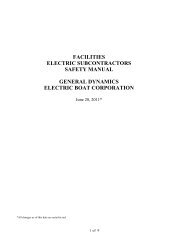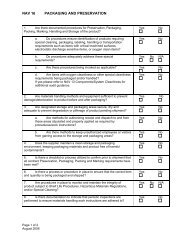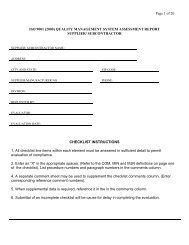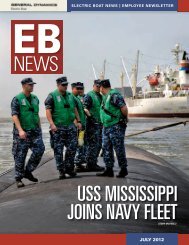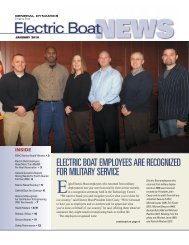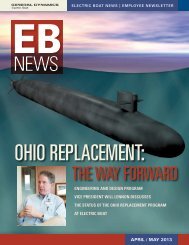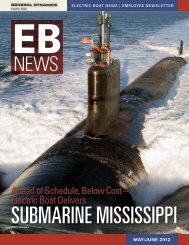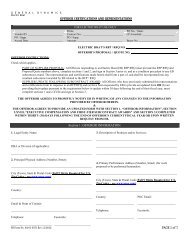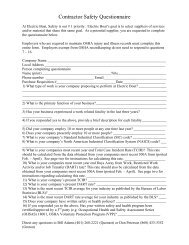EB news OCT 2002 bu - Electric Boat Corporation
EB news OCT 2002 bu - Electric Boat Corporation
EB news OCT 2002 bu - Electric Boat Corporation
Create successful ePaper yourself
Turn your PDF publications into a flip-book with our unique Google optimized e-Paper software.
AUGUST 2006Renovation of Graving Docks 1 and 2 is under wayINSIDEShippingport Gets Great GradesIn Review • 2Earned Hours,Where We Stand • 3Apprentices Sail Through SchoolAssignment • 3Marine Group Roundup • 5Health Matters • 6 / 7Casey Describes Direction For<strong>Electric</strong> <strong>Boat</strong> • 8 / 9Classifieds / Retirees • 10Service Awards • 11<strong>Electric</strong> <strong>Boat</strong> Begins Renovationof Graving Docks$65M project will improve shipyard’smaintenance and modernization capabilities<strong>Electric</strong> <strong>Boat</strong> earlier this month began the renovation of gravingdocks 1 and 2 at the Groton shipyard, which will enablethe company to <strong>bu</strong>ild upon its submarine-repair capabilitiesand help retain its workforce in Connecticut. The two-year project willcost $65 million. The docks are used for new submarine constructionas well as submarine maintenance and modernization work.“This project will solidify the company’s standing as a full-serviceshipyard for years to come, extending the life of the graving docks bymore than 50 years and reducing the costs associated with their operation,”said John Casey, <strong>Electric</strong> <strong>Boat</strong> president.Paul Harren (463), left,and Jeff Shafer (467) willbe closely involved inoverseeing the two-year,$65 million project torenovate graving docks1 and 2 at the Grotonshipyard. The work willextend the life of thedocks by more than 50years and enhance<strong>Electric</strong> <strong>Boat</strong>'s submarinemaintenance andmodernization capabilities.continued on page 9
The Shippingportdry dock at theGroton Naval SubBase.Shippingport Gets Great Grades In ReviewAs a retired Navy commander,<strong>Electric</strong> <strong>Boat</strong> ChiefDocking Engineer JosephHeery had some experience with drydocks.He commanded the drydock LosAlamos in Holy Loch, Scotland in the1990s, and later was in charge of the drydocksShippingport, Waterford and OakRidge for Submarine Squadron Two atthe Naval Submarine Base.So he knew what to expect when theNavy Board of Inspection and Surveycame this summer for the rigorous, twoday“INSURV” inspection of the drydockShippingport, which <strong>EB</strong> has operatedsince <strong>2002</strong>.“They inspect everything, every nookand cranny,” said Navy Capt. James P.Ransom III, who commanded RegionalSupport Group Groton at the time.“Every procedure you can do, they makeyou do it. It’s very intensive.”At the first INSURV in 2003, less thannine months after <strong>EB</strong> assumed responsibilityfor the Shippingport, the Boardfound a number of deficiencies. Heerywas determined to improve the drydock’sscores during this inspection, the firstcovering a period when <strong>EB</strong> was the solelyresponsible for maintaining and operatingthe drydock.Based on the INSURV board, theysucceeded, Ransom said.2 I August 2006 I ELECTRIC BOAT NEWS“The best grade you can get is ‘satisfactory,’and Shippingport got that, <strong>bu</strong>tat the outbrief, the Insurv team said the25 <strong>Electric</strong> <strong>Boat</strong> employees have done abetter job maintaining this craft than 100sailors before them,” Ransom said.Heery said he had expected to do wellon the INSURV, because Navy billets ona drydock are often filled with first-toursailors who have little familiarity withmaintenance issues such as painting andpreservation, while his team has extensiveexperience “This craft is ready to operatefor years into the future. It really validatesthe concept of having <strong>Electric</strong> <strong>Boat</strong>operating the drydock.”Ransom said the results were particularlyimpressive because the Shippingportis nearly 30 years old, having beenlaunched in 1977. It has been in servicein Groton since May 1979, when it conductedits first docking, of the Navy’sdeep-diving research submarine NR-1.“Any time you have an inspection, youwant to put your best foot forward, makesure you’re ready,” Heery said. “You’realways worried that you missed something.But all our "Dock Techs" pay a lotof attention to detail. We don’t want togive the INSURV Board anything – ifthere’s something wrong, we want themto search for it.”’Heery has had a long relationship withthe Shippingport. He was part of theNaval Submarine Support Facility inGroton when the craft did the NR-1docking in 1979, and has known all <strong>bu</strong>tone of the commanding officers.In the nine weeks before the inspection,Heery said his crew led by JimBush, Dock Engineer, corrected over 250potential deficiencies, and cleared numerousothers as they prepared for theINSURV Board’s visit.Heery said the Naval Submarine SupportFacility’s New England MaintenanceManpower Initiative also played akey role in the preparation, completing43 repairs that were beyond the capabilityof the Dock Techs. Heery said theHull Division in particular, led by KenWelch, completed about 80 percent ofthose repairs, and has done some maintenancethat might otherwise have to havebeen deferred to an overhaul period,such as replacing watertight doors andinstalling deck sockets for lifelines.“If they had a question, we were readyto answer it. We were ready to respond towhatever they needed,” Heery said. “Thisteam is always ready for an inspection.But I’m extremely pleased with theresults because it really shows what <strong>EB</strong>can do for the Navy. Everybody is benefitingfrom this arrangement.”
Dan Barrett,EditorBob Gallo,Gary Slater,Gary Hall,Photography<strong>Electric</strong> <strong>Boat</strong> News ispublished monthly by thePublic Affairs Department,75 Eastern Point Road,Groton, CT 06340Phone (860) 433-8202Fax (860) 433-8054Emaildbarrett@ebmail.gdeb.comEarned Hours • Where We StandApprentices SailThrough SchoolAssignmentAs an instructor at the shipyardapprentice school forthe steel trades, Steve Rileyuses the Shipfitter Theory II class togauge how well his students havelearned basic shipfitting concepts andwhether they can apply those lessonshands on.Typically, he said, by the timeapprentices reach his class, they haveaccumulated a few years of trade experienceand completed a number of prerequisitecourses. “The combination ofcontinued on page 4Kneeling at the stern of a cardboard boat <strong>bu</strong>ilt by an apprentice class is Jennifer Balzer; at the bow isNicholas Steinberg. Standing are, from right, Nestor Hernandez, Benny Contreras, John Bryer, RobertSocha, Joseph White, Archie Cochrane, Bjorn Liese and Robert King, Missing from the picture isJosh Zahansky.ELECTRIC BOAT NEWS I August 2006 I 3
continued from page 3“ By the time they finished theirproject, this class of steel-tradeapprentices made it clear that theyhave the determination and skillsthat will make them valuableemployees in their trade.”USS Jimmy Carter gets first deperming treatment.Silverdale, Wash.The Seawolf-class attack submarine USS Jimmy Carter (SSN-23) sits moored in the MagneticSilencing Facility at Naval Base Kitsap Bangor for its first deperming treatment. The depermingprocess reduces a ship’s electromagnetic signature as it travels through the water. Jimmy Carteris the third and final submarine of the Seawolf class. A unique feature of the Jimmy Carter is a100-foot hull extension called the Multi-Mission Platform, which provides enhanced payloadcapabilities, enabling the submarine to accommodate the advanced technology required todevelop and test a new generation of weapons, sensors and undersea vehicles.“already-completed training and workexperience should enable the students tocomplete an assignment without detaileddirections,” he said.The assignment this class received wasto <strong>bu</strong>ild a punt. After receiving instructionson the importance of working as ateam, the class members were given fourbasic views with two dimensions, overalllength and overall width, Riley said.“Additionally, the class members weregiven the two angles for the rake at thebow and stern, and told that the keelpenetrated the hull at amidships and was1/2 inch below the hull.”As the project progressed, the classmembers discussed the various featuresof the boat and developed simplesketches and freehand drawings. Fromthere, said Riley, a template was produced.This template, a flat pattern layout,was transferred onto sheets of cardboard.To simulate 3/8-inch plywood, twopieces were cut out and a strip was put allaround the edges. After the sides of theboat were completed, the bottom andends were formed into shape and tapedtogether.“This process continued until the puntwas complete,” Riley said. “By the timethey finished their project, this class ofsteel-trade apprentices made it clear thatthey have the determination and skillsthat will make them valuable employeesin their trade.”U.S. Navy photo4 I August 2006 I ELECTRIC BOAT NEWS
M A R I N E G R O U P R O U N D U PNASSCO Finalizes$1 Billion Contract ToBuild TankersSAN DIEGO, CAGeneral Dynamics NASSCO hasannounced it has finalized a $1 billioncontract with U.S. Shipping PartnersL.P. to <strong>bu</strong>ild nine product carriertankers. The contract includes optionsfor five additional ships. Constructionof the first tanker is scheduled to beginin the third quarter of 2007, with deliveryto occur by the second quarter of2009.“NASSCO is the leading <strong>bu</strong>ilder ofU.S. Navy auxiliary ships and has deliveredmore Jones Act ships than anyother shipyard in the country today,”said Frederick J. Harris, president ofGeneral Dynamics NASSCO. “Thiscontract is the largest commercial ship<strong>bu</strong>ildingcontract in NASSCO’s historyand positions this shipyard to remainthe premier <strong>bu</strong>ilder of Jones Act ships.”The product carrier tankers or “PCs”will be 183 meters (600.4 feet) in lengthand 32.2 meters (105.6 feet) in beam,with a design draft of 11.8 meters (38.7feet). The ships are to be double hulled,weighing 49,000 dead weight tons(DWT) and will have a cargo capacityof 331,000 barrels.The PC tankers are based on an existingdesign from DSEC, a wholly ownedsubsidiary of Daewoo Ship<strong>bu</strong>ilding andMarine Engineering of Seoul, Korea.NASSCO entered into an agreementwith DSEC last March to produce shipsfor the U.S. market under the Jones Act,in which DSEC will provide detaildesigns and services related to constructionof the ships. All of the ships will beconstructed at the NASSCO shipyard inSan Diego.The PCs are the second class oftankers NASSCO has been contractedto produce since 2000. Earlier thismonth, NASSCO delivered its finaldouble-hulled tanker to BP ShippingCompany of Alaska under a four-shipcontract. By comparison, the BPtankers are 185,000 DWT, 287 meters(941 feet) in length, and have a capacityof about 1.3 million barrels.<strong>Electric</strong> <strong>Boat</strong> Awarded $6 Million to SupportPost-shakedown Work On Submarine TexasThe U.S. Navy has awarded General Dynamics <strong>Electric</strong> <strong>Boat</strong> a $6.3 million contractmodification to procure long-lead-time material in support of the USS Texas post-shakedownavailability (PSA).The award is in anticipation of an $85 million contract the Navy in January announcedthat it would assign to <strong>Electric</strong> <strong>Boat</strong>. This work will comprise maintenance, repairs, alterations,testing and other activities and is scheduled to begin in early 2007 following completionof Texas’ shakedown period. Most of the PSA will be performed at <strong>Electric</strong> <strong>Boat</strong>’sshipyard here, and is expected to be completed in December 2007.The second ship of the Virginia Class, Texas was delivered to the Navy in June byNorthrop Grumman, <strong>Electric</strong> <strong>Boat</strong>’s teammate in the Virginia-class submarine constructionprogram. <strong>Electric</strong> <strong>Boat</strong> and Northrop Grumman have received contracts to produce10 Virginia-class ships.<strong>Electric</strong> <strong>Boat</strong> delivered the first ship of the class, USS Virginia (SSN-774), in October2004 and is now performing a PSA on that ship. This work, also worth about $85 million,is scheduled for completion in December.BIW Awarded $116M Contract For DDG-1000Zumwalt Class Transition And Detail DesignThe U.S. Navy has awarded Bath Iron Works, a subsidiary of General Dynamics(NYSE: GD), a $115.8 million contract to commence DDG-1000 Zumwalt class destroyerdetail design and procurement of Vendor Furnished Information (VFI) to support detaildesign. The total value of the detail-design effort, after all contract options have been fullyfunded, will be in excess of $300 million. This program was formerly known as the DD(X)destroyer program.The mission of the DDG-1000 is to provide independent presence and deterrence and tooperate as an integral part of naval, joint or combine maritime forces. DDG-1000 will provideadvanced land-attack capability in support of ground campaigns and contri<strong>bu</strong>te tobattlespace dominance in littoral operations.NASSCO Lays Keel Of Fourth T-AKE Ship,USNS Richard E. ByrdSAN DIEGO, CA– General Dynamics NASSCO recently held a keel-laying ceremony for thefourth ship in the U.S. Navy’s T-AKE program. The ship is named USNS Richard E. Byrdin honor of the U.S. Navy admiral who explored the South Pole and Antarctica. The vesselwill be part of the Lewis and Clark-class of dry cargo-ammunition ships.Debbie Hamilton, the wife of Rear Adm. Charles Hamilton II, the Navy’s program executiveofficer for ships, was the honoree for the event and welded her initials into the keel.The Richard E. Byrd is scheduled to be delivered to the Navy in the fourth quarter of2007.At the ceremony, Rear Adm. Hamilton announced that T-AKE 4 would be named afterthe South Pole explorer, and that the fifth ship of the class would be named the USNSRobert E. Peary in honor of the Navy rear admiral who was one of the first men toexplore the Artic circle. The ships of the T-AKE class are expected to be named in honorof legendary explorers.NASSCO has been awarded contracts to <strong>bu</strong>ild nine T-AKE ships for the Navy. Twoadditional ships are expected to be ordered by the Navy over the next two years for a totalclass of 11 ships. The first ship of the class, USNS Lewis and Clark, was delivered to theNavy June 20. Four follow-on ships are currently under construction at the NASSCOshipyard here: the Sacagawea, Alan Shepard, Richard E. Byrd and Robert E. Peary.ELECTRIC BOAT NEWS I August 2006 I 5
Bob Hurley, MDMedical DirectorHEALTHMATTERSPotts, Carcinogensand GrillsThe British physician Sir Percival Pottswas the first to suggest that agents in theenvironment might induce cancer. Histime was the late 1700s when England<strong>bu</strong>rned coal and wood for heating. Theneed to sweep soot from chimneys wasconstant and many individuals madetheir living by physically going down thechimneys to remove it. Dr. Pottsobserved that this group of workers hadincreased rates of scrotal and nasal cancers.Utilizing the new science of epidemiology,Potts was able to correctlylink the soot exposure to these cancers.Soot is a complex mixture of chemicalsthat arise from the partial com<strong>bu</strong>stion oforganic material. One of the constituentsof soot is a class called polycyclicaromatic hydrocarbons or PAHs.We now know that PAHs act as procarcinogens;they do not cause cancerdirectly <strong>bu</strong>t rather are converted by liverand lung enzymes to active carcinogens.For example, cigarette smoke contains awide variety of procarcinogens that areturned into active carcinogens. Sincesmokers draw PAHs into their lungs witheach inhalation, smoking is a very effectiveinducer of lung cancer.Where There’s Smoke,There’s Cancer RiskGrilling meat, poultry, or fish –whether over wood, charcoal, or gas –exposes the food to two separate carcinogenicagents. Polycyclic aromatic hydrocarbonsare found in the smoke createdwhen fat drips from meat, chicken skin,or fatty fish onto a heat source. ThePAH-filled smoke coats the food, whichwe then ingest.The second type of carcinogen, heterocyclicamines (HCAs), develops in meat,poultry, and fish cooked over high heat.Extreme temperatures prompt a reactionbetween the food's natural aminoacids and creatine, a substance found inmuscle tissue. HCAs are the product ofthat reaction. HCAs can also form infoods that are broiled, especially welldonered meat.These two substances are importantas researchers found in a 1996 studythat people who eat their beef well doneare more than three times as likely todevelop cancer as those who prefer theirsteaks medium-rare or rare. Otherresearch suggests a link between colorectal,pancreatic, and breast cancerwith individuals who consume largeamounts of well-done, fried, and barbecuedmeats.Safer GrillingGuidelinesBelow, you'll find several tips to help youenjoy your treasured grilled foods. In makingjust a few changes you'll be able tomarkedly reduce your risk of cancer fromthe foods you consume.Say no to well done.You now know that the longer you grillfood, the more cancer causing agents aredeposited on it. At the very least, eat welldonemeat sparingly. On the other handyou need to cook your food enough to killbacteria like E. coli.Precook your foods.One way to limit the time and high temperaturesof the grill is to partially cookthe meat or poultry in the microwave fortwo to five minutes. This draws out mostof the potentially harmful chemicals withoutsacrificing moistness. You can alsoplace it in the oven at a low temperature.These techniques also prevent the charredon-the-outside,raw-on-the-inside result.To prevent bacteria from multiplying, grillthe food immediately after precooking. Bydoing this, you eliminate 90 percent ofHCAs.continued on page 76 I August 2006 I ELECTRIC BOAT
Keep the fat to a minimum.Cut down on carcinogens by grilling onlylean cuts of meat, trimming all visible fat,and removing the skin from chicken. Highfatmeats such as sausage and ribs should beeliminated altogether. Use tongs or a spatulato turn foods instead of a fork. Piercingmeat with a fork allows fats and juices todrip down onto the hot coals which causeflame-ups.Flip your <strong>bu</strong>rgers often.By turning <strong>bu</strong>rgers once a minute and cookingthem over a low heat, you reduce HCAsand kill potentially deadly E. coli bacteria.In addition, use a meat thermometer tomake sure the meat reaches 160 degrees, thetemperature required to deactivate E. coli.Although the meat may be brown, thatdoesn’t mean it is thoroughly cooked.Grill fish instead.Fish generally contains less fat than meatand poultry, which makes it less likely tocreate PAH-carrying smoke. And it tends torequire much less time on the grill, reducingits exposure to carcinogens.Clean your grill.Scrub your grill thoroughly after every useto avoid a <strong>bu</strong>ildup of carcinogens that canbe transferred to your food the next timeyou grill. For tough grease, put the dirtyrack into a plastic garbage bag. Add waterand dishwashing liquid and leave overnight.Brush off the residue and rinse. You mayalso want to heat the grill before placingfood on it to kill any surviving bacteria. Ifyou have a gas grill with permanent briquettes,turn them greasy side down, lightthe grill, and with the temperature at high,close the cover. After 20 minutes the briquetteswill be as good as new. Prior togrilling, apply some oil to cooking surface –it keeps charred material from sticking tothe food and keeps fish and chicken in onepiece.Use aluminum foil.Make tiny holes in a piece of foil and placeit on the grill underneath your meat. Theholes let the fat drip down, and the foilreduces the amount of smoke the billowsback up. Wrapping the meat completelywith perforated foil is even better.Lower the heat.On charcoal grills, increase the distancebetween the food and the hot coals byspreading the coals thinly or propping thegrill rack on bricks. Simply adjust the heatsetting on gas grills.Stick to charcoal and hardwood.Barbecue briquettes and hardwood products,such as hickory and maple, <strong>bu</strong>rn atlower temperatures than softwood and softwood(pine) chips. Mesquite chips areslightly less safe than those made of otherhardwoods <strong>bu</strong>t are safer than softwoods.Marinate for Your Health's Sake.One piece of good <strong>news</strong> is that you can dramaticallyreduce the hazard of grilling bymarinating your food. Marinades not onlymake grilled foods taste better, they alsomake them safer. A chemist at the LawrenceLivermore National Laboratory in Californiafound that marinating chicken in a simplemixture of olive oil, cider vinegar, garlic,mustard, lemon juice, salt, and brown sugarreduced carcinogenic compounds in the finishedproduct by more than 90 percent. It’sthought that marinating draws out the procarcinogens.You'll have to use the correctmarinade, though. A thin liquid for at least10 minutes is recommended. Thick commercialsauces should be diluted as theHCAs triple when you use them. The onlycaveat is to treat marinades, which drawbacteria from meat and poultry, as a rawfood. To use a marinade as a serving sauce,set aside a portion before you place themeat in it or boil it for three minutes beforeserving.Additives.To reduce your exposure to HCAs, you canadd ingredients such as 1/2-cup of texturedsoy protein into a pound of ground meatbefore grilling. Vitamin E can be added orsprinkled on ham<strong>bu</strong>rgers. Garlic, rosemaryand sage whether sprinkled on or used in amarinade all reduce your risk.RecipesHere are a few marinade recipes that lowerthe HCAs and your risk of cancer. Whydon’t you give them a try?Teriyaki SauceOne garlic of clove1/2 teaspoon minced fresh ginger2 tablespoons brown sugar1/2 cup soy sauce1/2 cup waterMix all. Pour over meat, fish or poultry.Marinate at least ten minutes.1 cup.Turmeric Garlic Marinade2 tablespoons garlic powder1 teaspoon ground turmeric1/2 cup orange juiceMix all. Pour over meat, fish or poultryand marinate at least ten minutes.1/2 cup.Rosemary Tea Marinade1/2 cup concentrated tea (two bagsbrewed in 1/2 cup hot water for fiveminutes)1 teaspoon crushed rosemary1 garlic clove, crushed2 teaspoons honey2 teaspoons soy sauceAdd rosemary, garlic, honey and soysauce to hot tea. Cool slightly. Pourover steaks, ribs, <strong>bu</strong>rgers, chicken orfish. Marinate at least ten minutes.1/2 cup.ELECTRIC BOAT NEWS I August 2006 I 7
Q&ACasey Describes Direction For <strong>Electric</strong> <strong>Boat</strong>Editor’s note: In an interview with <strong>Electric</strong> <strong>Boat</strong> News, <strong>EB</strong> President John Casey discussed the company’s near- and mid-term direction andgoals, as well as the actions that must be taken to accomplish these objectives. The exchange follows:Would you describe <strong>Electric</strong> <strong>Boat</strong>’s direction and goals over the next 12 to 18 months as wellas how you expect the company will achieve these goals?We remain focused on our threecore lines of <strong>bu</strong>siness – construction,engineering and design, and maintenanceand modernization. I’ll talkabout each of these in turn.In the construction <strong>bu</strong>siness, we stillhave a considerable backlog in theVirginia class program. Virginia (SSN-774) and Texas (SSN-775) have beendelivered; our focus now is on deliveringHawaii (SSN-776). We’re off to avery good start – the people committedto this program are doing anexcellent job. And Newport News iswell along on North Carolina (SSN-777). That will complete the Block Iships.Our next objective is to achieve significantsavings on theBlock II ships,John Caseywhich would lead us to a $2 billionper-ship cost and ultimately support atwo-ship per-year procurement rate.The Quonset Point facility is relativelystable at one ship per yearbecause they are <strong>bu</strong>ilding modules forships being delivered to both Grotonand Newport News. Unfortunately,on the Groton waterfront, delivery ofonly one ship every other year resultsin a cyclical workload, which is notthe way we want to manage the <strong>bu</strong>siness.That’s why it’s so important forus to get to two submarines per yearas soon as possible. The Navy’s currentplan would begin that rate ofproduction in 2012; we would like towork with the Navy and our Congressionaldelegation to accelerate thatschedule to 2010 or 2011. Thatwill be a formidable challenge,primarily because of <strong>bu</strong>dgetpressures on the Departmentof Defense.On the Engineering andDesign side of the <strong>bu</strong>siness,as we’ve said on previousoccasions, there is nonew design for the first timein the more than 50-yearhistory of the U.S.nuclear submarineforce. It appears that the Navyis now laying the groundwork toaccelerate the next new design; theRAND organization is conducting astudy for NAVSEA, which will providean independent assessment of theactivity required to sustain the designindustrial base.I believe there is recognition of therequirement for a new design and Ibelieve we’re making headway in twomajor areas – one of these is to modifythe Virginia design to make it moreaffordable, and the second is to acceleratethe design of the next missilesubmarine, which may carry conventionalor strategic missiles.There appears to be growing recognitionthat this new design is importantnot only for <strong>Electric</strong> <strong>Boat</strong>, <strong>bu</strong>talso for the Navy and the nation.The congressional committees thatinfluence these decisions also haverecognized this need, either by allocatingfunds or stating it as a desiredobjective.So I’m confident that we’re gettingthe message across that we need topreserve our engineering and designcapabilities so that the country retainsthe ability to design nuclear submarines.I believe we’re going to see anincreased recognition of the need for anew design as well as increased supportfor the design activity itself.The maintenance and modernization<strong>bu</strong>siness has a different set ofchallenges. In the near term, wehave obtained a good deal morecontinued on page 98 I August 2006 I ELECTRIC BOAT NEWS
continued on page 8work than we had anticipated last year at this time. Specifically,we’ve obtained two availabilities – the USS Miami (SSN-755)Selected Restricted Availability under way at the sub base andthe USS Albany (SSN-753). Although we don’t have the contractfor that availability yet, we’re involved in the planning forthis activity, which will take place at the Norfolk Naval Shipyardin Virginia. We secured these two jobs in part because the Navyhas more maintenance requirements than they have resources toperform them.The SSGN program, however, is nearing completion. Thatwas a very significant project for <strong>Electric</strong> <strong>Boat</strong>, both on the manufacturingside as well as at our offsite locations at Puget Soundand Norfolk. This activity will wrap up by year end at PugetSound and next year at Norfolk, and that will impact the size ofour work force.Our first priority in the maintenance and modernization <strong>bu</strong>sinessis the home port activity in Groton. We’re going to investmore than $65 million – with the support of the state of Connecticutand the Navy – to re<strong>bu</strong>ild graving docks 1 and 2. Ultimately,we will have the only graving docks on the ThamesRiver. There will be a significant number of submarines homeportedat the sub base and we will lease this capabilty to theNavy. We anticipate receiving a share of the work associatedwith these ships as they enter our graving docks.The other area we need to be focused on over the long term isthe Navy’s emphasis on the Pacific Ocean – the current plan is toassign about 60 percent of the fleet’s attack submarines andmore than half of its SSBNs to that theater. We are in theprocess of determining how <strong>Electric</strong> <strong>Boat</strong> can support theNavy’s activities in the Pacific. I think there are opportunitiesthere, and we are now developing ways we can provide supportfor those ships.To summarize, over the next year, the engineering and designwork load will be much more stable than we thought it would bea year ago. This stability is largely the result of new activity inwhich we’ve become engaged as a result of actions by both theNavy and Congress to ensure that we retain the industrial capabilityto support the next major design.On the construction side, we’re still planning for some reductions,although they’ve been alleviated by some of the contractswe’ve won. To compete and win new jobs, and continue our participationin the construction <strong>bu</strong>siness we have to ensure that weare affordable. We have to be the low-cost provider, and at thesame time, maintain our high quality standards. I think we’reworking well in this direction.Looking forward, we need to focus on delivering the six BlockII ships. The first of these, the SSN-778, will begin to arrive inGroton as major modules in a few months. And as these modulesarrive, we have to complete the pressure hull and demonstrateto the Navy and Congress that our learning curve gainswill ultimately support two ships per year at about $2 billion percopy.We’re looking at a couple of specific ways to do that. One is toshorten the time required to deliver a ship, which will dramaticallyreduce the cost and close in on the $2 billion per ship target.We seem to be on the right path to reduce the total numberof hours it takes to <strong>bu</strong>ild a ship. Hawaii is on a very good trackand it looks like we’re going to achieve our objectives, especiallyif we can deliver the ship by the end of the year. We also have tomodify the acquisition process so that that the materials neededto <strong>bu</strong>ild the ship are delivered in time to support an acceleratedschedule.One initiative that’s been particularly helpful to us as we movetoward that goal is our continuous improvement program, withits spectrum of grass-roots level efforts and the more globalLean Six Sigma activities that are occurring throughout thecompany. Through this program, we’ll help ensure that wechange processes in a way that makes us more efficient and moreaffordable, and brings us closer to our objective of <strong>bu</strong>ilding two,$2 billion ships per year.continued from page 1“The scope of the work involved isenormous,” said Engineering ManagerJeffrey Shafer (467), who is overseeing theproject. “To complete the renovations, wewill pour 32,000 cubic yards of concreteand use 7 million pounds of rebar, steelbars used to reinforce concrete. Additionally,210 rock anchors and 266 tie rodswill be installed in the docks to helpsecure 1,345 linear feet of sheet steel thatwill be used to <strong>bu</strong>ild new retaining wallsaround the docks.A key element in the renovation projectis the participation of the state of Connecticut,which is providing about $20million in assistance. This includes about$10 million in loans from the Departmentof Economic and CommunityDevelopment, up to $4 million in a salesanduse-tax exemption from the ConnecticutDevelopment Authority andabout $6 million in enterprise-zone benefits.The U.S. Navy is supporting the projectthrough a pending contract, whichwill reserve space in the reconstructeddocks to perform repair work on submarineshome ported at the Groton navalbase.ELECTRIC BOAT NEWS I August 2006 I 9
Classified$AUTOS/TRUCKSCHEVY S-10 BLAZER 1989. VortecV6, automatic, 4X4, runs good, faircondition. 160K miles. Needs somerepair work. $500 OBO. 536-6358.DODGE WINDSTAR VAN 1996.245K miles. Sell as is - $950. 440-3391.FORD EXPLORER XLT 1999. V6,auto, sunroof, leather, CD, verygood condition. $6,700. 859-9146.AUTO PARTSSTEEL 14” RIMS (4) with usedsnow tires. For Mazda 626. Excellentcondition. 295-1274.BOATS1975 16’ aluminum Starcraft; 199228HP Johnson outboard; 1995trailer. Complete package $1,750.443-6518.KAYAK. Perception Eclipse 17’ withrudder. Red & yellow. Excellentcondition, used twice. Front & rearhatches for storage. $750. 376-7957.FURNITURECHINA HUTCH. Glass doors, goodcondition. $50. Child’s rocking chair,oak, excellent condition. $60. 464-8506.MISCELLANEOUSAMERICAN GIRL DOLL clothes &furniture. Child’s rocking chair, dollhousefurniture, wooden doll’s cradle,new porcelain doll, Fisher Priceschool house, Crissy doll, ElvisPresley doll. 401-596-5788.COLEMAN POP-UP camper. LPtank, inverter, stove, sink, sleeps 4-5. Very good condition. $1,800. 859-9146.LESCO walk-behind mower. Pullstart, 5-speed w/reverse, belt drive,32-inch cut, 13HP, Kawasaki FC420VOVH. Only used 44.6 hours. $1,200.445-7354.LITTLE TYKES country kitchen,$30. Little Tykes art desk, $20. LittleTykes giant <strong>bu</strong>ilding blocks, $10.Small pets’ playpen, brand new,$25. 442-8659.OFF WHITE wedding gown withmatching headpiece. Excellent condition.Vintage jewelry, fertilizerspreader, draperies, custom-madeslipcover for couch, Fostoria glassware,Mickey Mouse earrings. 401-596-5788.SMALL TRAILER, new Bridgestonetruck tire M773, size 245-75-16.Framed dresser mirror, 2 new fluorescentfloor lamps, 3-way system,energy saving. $12 each. 401-596-4519.WATERBED soft side. Queen. $200.Retro floor lamp, marble base,brass, three lights, $50. Largeoil/canvass abstract painting,mauve, teal, black. $50. 608-0301.MOTORCYLESHARLEY DAVIDSON 2004 SofttailHeritage. VH pipes, 4K miles, perfectcondition. Booked at $15,995;make offer. 443-6518.To submit a classified ad, send an e-mailto <strong>EB</strong>NewsAds@gdeb.com with the following information:PETSCATEGORY choose fromAppliancesAutos / TrucksAuto Parts<strong>Boat</strong>sComputersFurnitureMiscellaneousMotorcyclesBIRD Sun Conure. With large cage.$350. 376-7957.REAL ESTATE / RENTALSENJOY THANKSGIVING in St.Maarten. 11/18-11/25. SunterraFlamingo Beach. 1 BR. Sleeps 4,full kitchen. $550. 376-9029.LONGBOAT KEY, FL. For rent –2B/2B condo, washer/dryer, cable& carport. On canal, next to park,walk to semi-private beach.$600/week - $2,000/month. 401-783-1273.PetsReal Estate /RentalsITEM NAME; DESCRIPTION; ASKING PRICE; andHOME TELEPHONE (include area code if outside 860).Deadline is the 15th of the month.Maximum of two 25-word ads per employee per issue.Please include your name, department and workextension with your ad (not for publication).Dan Barrett,<strong>EB</strong> Classified, Dept. 605,Station J88-10.REAL ESTATE / SALESCOLCHESTER condo. HighlandFarms, 2BR, 2 BA, FP, deck, garage,walk-out basement, end unit.$249,000. 608-0301.WANTEDReal Estate /SalesWantedEmployees without e-mail can submit their ads throughinteroffice mail to:ALUMINUM BOAT with motor. 14’to 16’. Also, small sailboat. 10’ to14’. 443-4101.FREE LOGS. 10” to 50” diameterand 8-1/2’ or longer. With portableband saw and waste removal. 691-2479 from 9 AM to 10 PM.Retirees230 George R.Molyneux31 yearsRigger 1/C230 George A. Benoit33 yearsRigger 1/C323 Terence J. Lardner31 yearsQuality ControlAnalyst Sr.330 Robert E. Sundman38 yearsEngineering333 David D. Weber33 yearsMaterial Coordinator341 Lewis C. Hassell Jr.29 yearsEngineering Asst. Sr.355 Michael H.Cardinal35 yearsSupv. of Planning403 Dennis G. Mathers30 yearsSupv. Eng. Services404 John P.Blanchard Jr31 yearsQuality ControlAnalyst435 Ernest L. Crandall10 yearsEngineer Senior448 Charles W.Shoenfelt21 yearsEng. Asst. Project453 Harold Jensen18 yearsMech. Sr. Designer456 William F. Orkney34 yearsSupervisor, Design492 Edwin M. Batson16 yearsEngineer Senior501 Paul L. Romagna40 yearsSr. Mfg. Rep.615 David P. Lamb27 yearsMgr. of Finance629 Edward J.Behney Jr.31 yearsBusiness Dev.Spec.702 Laura Cousineau21 yearsAdmin. Assistant705 Edward F. Lucke20 yearsPlanner Senior901 Edward J. Gavitt Jr25 yearsInstall. Tech. III901 Russell R. Holland30 yearsInstall. Tech. III915 Raymond J.Shannon23 yearsInstall. Mech. I915 Joseph D. Mopps26 yearsM/T Tech. II915 Ellsworth W.Beverly Jr.42 yearsForeman957 Thomas L. Schmitz32 yearsPlanning Specialist10 I August 2006 I ELECTRIC BOAT NEWS
Service Awards40 years 20229 Robert F. Burkle 902 Bruce E. Sullivan230 William D. Steele 904 Oscar S. Butler Jr.242 George G. Leiper Jr. 904 Terrence Slattery355 Robert A. Nowak 252 Chester J. Drong 915 James E. Bisordi35333 Carol A. Rondeau 921 David H. Dudek242 Bradley J. Woodyears355 Allen S. Hopfer921 Mark E. Simonds243 David B. Crowley425 Shirley M. Lemay 921 George D. Vincent429 Steve A. Valach428 Yvonne Miranda 950 Steven A. Woolley447 Laurie L. Stevens438 William N. Joseph Jr. 252 Timothy J. Livesey 915 Michael C. Morrison229230Gary C. HollowayThomas B. Christiansen433 Elaine B. Woods 957 Barbara A. Betley452 Shawna M. Bailey251 Bernard F. Payne 434 Peter F. Justin25459 Gary A. Riebesehl410 Richard W. Partelo 447 John W. Mularz414 Omar D. Hall II449 James R. Mack462 Alec C. Allison462 Joselito D. Argarin417 Diane L. Am<strong>bu</strong>rn 453 Anthony L. Kiertianis501 Robert E. Judd447 Paul F. Bergel Jr. 459 Joseph E. Berg242 Roderick D. Ford641 Kathleen R. Szarzynski456 James K. Procious 459 Mark A. Delaura242 Samuel Rios650 Tammy L. Young604 Burton F. Gischner 459 Edward D. Greene243 Edward J. Donat866 Bonnie K. Hoffman30459 Louis J. Piette Jr.Perkins252 David B. Lacoss496 Bruce L. Wood902 George M. Lima252 Frank R. Tagliatela501 Earle A. Gainsley Jr.915 Donald J. Oldroyd252 Michael K. Taylor501 Jeffrey C. McKibben924 Matthew Williams274 Melvin L. Daniels604 Cynthia J. Malaguti962 Vincent Arakelian330 Michael A. Trask100 Terrence Brennan Jr. 626 Sharon A. Rathbone962 John Santos452 Karen S. Oddo100 Philip D. Lee650 Timothy P. Banning452 Athan E. Tasoulas100 David W. Paradis 662 Michael J. St. Germain507 Stanley W.226 Mark H. Ciliano795 Michael A. BoucherKondratowicz226 John W. MacGregor 811 Roland A. Duquette 902 William B. Senuta226 Michael J. Slattery 821 Robert A. Tellier 915 Henry A. Knight IIIELECTRIC BOAT NEWS I August 2006 I 11
STANDARD PRESORTU.S. POSTAGEPAIDGROTON, CTPERMIT NO. 39215658172.3or lessor less



